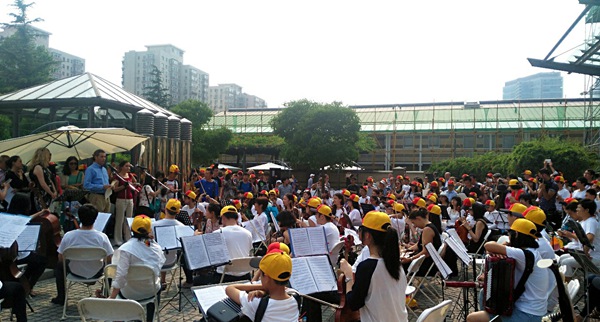

 |
|
Volunteers perform Ode to Joy, in Beijing on Saturday.[Photo/chinadaily.com.cn] |
Beijing heard a sonorous Ode to Joy Saturday afternoon, when a thousand volunteers belted out the tune in German and Chinese at the German Embassy.
From primary school students to retirees, a choir in several parts and an orchestra of western as well as traditional Chinese instruments were convened in the last month for the event, aiming to bridge German and Chinese in culture.
The performance saw two countries come together, said Michael Clauss, the German Ambassador, at the opening. He also said that China and Germany share a lot in common, loving music, singing and making friends through it is one of the many similarities.
Violins, cellos, trumpets stood next to erhu (a two-string instrument), Chinese flute and Chinese Zither. Ode to Joy was first sung in German and then in Chinese rendition.
"I've especially chosen a Beijing cloisonné glazed Hulusi for today's performance because it gives our local Beijing flavor",Pan Wenwei, a college student said. Hulusi is a Chinese wind pipe instrument that looks like a gourd.
"I have also wondered if Chinese instruments will go with Beethoven in an orchestra," Pan said. "Turns out it's great."
"It's so fun! I love playing Ode to Joy with my Zheng!" Xie Huiyu, a seven-year-old who plays Chinese Zither exclaimed. Her mother was also in the choir.
"It's a perfect experiment," Maria Nauen, the Beijing International Chamber Orchestra conductor who saw over the ad hoc orchestra said. "Music is an international language. Every instrument, western or Chinese, goes together very smoothly speaking the same language. "
"Beethoven should be very happy today," the conductor said.